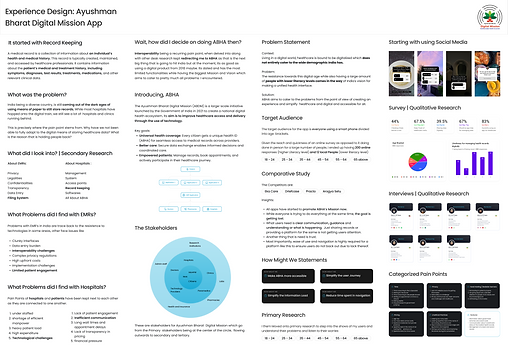
Ayushman Bharat Digital Mission application redesign
The Ayushman Bharat Digital Mission (ABDM) is a transformative initiative launched by the Government of India to create a national digital health ecosystem. Its primary goal is to improve access to healthcare and empower citizens to manage their medical information effectively.
About
Enhancing ABHA's user experience by optimizing navigation, flow, and interface, while introducing new features.
Duration
January 2024 - April 2024
16 Weeks
Deliverables
User Experience Design
User Interface Design
Research Paper

Research Overview
Secondary Research
Primary research

India's Healthcare status

India's healthcare system faces several critical challenges, including a shortage of trained medical professionals, particularly in rural areas, leading to inadequate patient care. Urban-rural disparities further widen the gap, with urban areas having better infrastructure and specialized care, while rural regions struggle with limited resources. Financial constraints and low health insurance penetration result in delayed or avoided treatments, exacerbating health issues.
Insufficient public healthcare funding has led to a heavy reliance on private services, which are often unaffordable, with Indians spending a significant portion of their healthcare expenses out of pocket—around 55% in 2019. Additionally, fragmented healthcare access due to socioeconomic disparities affects vulnerable populations, and the growing burden of diseases continues to strain the system, despite projected increases in healthcare spending, expected to reach 2.5% of GDP by 2025.
Current Problems in our healthcare system

Doctors lack access to patient medical history, remote consultation options, and streamlined business operations, while patients struggle with inaccessible medical records, limited doctor and hospital information, and skipped treatment follow-ups. Additionally, remote consultations are unavailable, and medicine supply remains inadequate, affecting overall healthcare efficiency.
Understanding the ABHA Ecosystem
Every citizen receives a unique ABHA address. It’s like a virtual health ID that unlocks a secure way to store and share your electronic health records Hospitals, clinics, labs, and pharmacies can connect with ABHA.
This allows them to link your EHRs securely, creating a comprehensive health history. With your consent, authorized providers can access specific parts of your medical records, improving diagnosis and treatment.

Stakeholder Mapping
The proposed ABHA value exchange chain connects key healthcare stakeholders, enhancing connectivity, telemedicine, and record management for patients. Doctors, nurses, and lab technicians gain discoverability and centralized treatment data, while insurance companies streamline claims processing. The NHA oversees data management, the medical council handles professional verification, and pharmacies expand their reach and manage stock. This framework promotes accessibility, transparency, and efficiency in healthcare.


Competitor Analysis
Primary Research
Secondary research

Eka Care
Strengths:
• User-friendly interface
• Online consultations
• Medicine delivery
Weakness:
• Limited reach beyond metros
• Data privacy concerns
01
Research Overview
Target audience

How might we statements

Survey Research
Social media research
Qualitative research
Quantitative Research
Social Media at it's best use

Behavioural Insights:
1. The audience highly engaged with polls with an interesting visual and some peppy music
2. as long as it makes their life easy, they are willing to make an effort.
3. Answers reduced significantly once they were asked to write their answers or think too much
4. Low effort questions and solutions are highly attractive and effective
Quantitative Research

The questions
A survey was rolled out to about a 200 people which us gave an idea about their pre hospital visit habits, during and post. Since this data was collected via google forms, it also gave us an idea of the age demographic and financial background which widened the research and gave a lot to chew on.
This added a lot more value to the second part of the research which was qualitative.

The findings
Qualitative Research
The quantitative research gave us a wide range of personas which were narrowed down to two categories based on literacy levels: Higher and Lower Literacy levels. These were the umbrella categories which further had different personas based on age brackets, hospital experience and medical histories in relation with hospital visits.

Higher Literacy Level Personas

Lower Literacy Level Personas
Pain Points Collected and Categorised
Pain points were gathered from key stakeholders—patients, doctors, the NHA, and hospitals—across the following categories:
-
Time
-
Privacy
-
Hand-holding & Bedside Manner
-
Pricing
-
Unethical Practices
These pain points were then ranked based on their frequency and overall impact. The most recurring and critical issues were prioritized, and similar concerns were consolidated under their respective categories. This structured analysis informed the development of a feature list tailored to address these challenges effectively.


Design Iterations
Wireframes

Design System




Prototype






